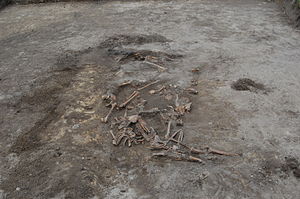- Massacre of Wola Ostrowiecka
-
Massacre of Wola Ostrowiecka was a mass murder of Polish inhabitants of a Volhynian village of Wola Ostrowiecka, located in the prewar gmina Huszcza, Luboml county, in the Volhynian Voivodeship of the Second Polish Republic.
The perpetrators were nationalists of the Ukrainian Insurgent Army’s territorial command Piwnicz, supported by local Ukrainian peasants. On August 30, 1943, the Ukrainians surrounded the village, and began murdering its inhabitants. Altogether, 79 families were completely wiped out, and out of additional 37 families, only one person survived[1]. It has been estimated, that in total at least 469 persons were murdered on that day, and among the victims, there were 145 women and 179 children under the age of 16. Tadeusz Piotrowski puts the number of murdered Poles at 529[2], out of total village's population of 870. On the same day, Ukrainian nationalists murdered 438 Poles in the neighboring village of Ostrowki (see Massacre of Ostrowki).
According to the Polish survivors of the massacre, the perpetrators had been preparing the attack for a few days in advance. The Poles noticed that their Ukrainian neighbors were drinking heavily, chanting anti-Polish slogans[3]. In the morning of August 29, the Ukrainians surrounded the village. At first, they acted in a friendly way, talking to children, and asking men to gather in a square in front of the school. An UIA officer made a speech, in which he urged Poles to fight the Germans, alongside the Ukrainians. At the same time, in the outskirts of the village, holes for dead bodies had already been dug. After the speech, all Polish men were asked to come for “physical examination”, in a barn, one by one, they were killed by a blow to the head with a blunt object[4].
After all men had been killed, the time came for women and children, who were locked in the school building. One of the survivors, Marianna Soroka, who was a child back then, told later that they began singing religious hymns, and their mother told them to prepare for death. Another survivor, Henryk Kloc, who was 13, stated that the Ukrainians set fire to the school, and then they began firing at it, and throwing grenades inside. Kloc, heavily wounded, lay among the dying in a school orchard, watching the murderers kill a five-year old son of Maria Jesionek. The woman had already been dead, and her son was sitting next to her, calling her to go home. “Suddenly an armed Ukrainian came to him, and shot the boy in the head” - told Kloc later. He survived, because he played dead[5]. As soon as the massacre ended, local Ukrainian peasants began looting the village. After the massacre, commander of the Ukrainian Insurgent Army’s unit reported: “On August 29, I carried out the action in villages of Wola Ostrowiecka and Ostrówki. I liquidated all Poles, from the youngest to the oldest ones. I burnt all buildings, and appropriated all goods”[6].
Between August 17–22, 1992, Polish scientists carried out exhumation in the area where once the village was. During the exhumation, it was established that in most cases, the murderers used of the head of an axe or a bludgeon[7]. Wola Ostrowiecka does not exist any more, local Ukrainians call the village “Field of Dead Bodies”. Every year, Polish survivors and their families organize a pilgrimage to what once was Wola Ostrowiecka. In 2003, the village was going to be the center of celebrations of the 60th anniversary of the Volhynian Genocide. However, at the last moment, plans were changed, and presidents Aleksander Kwasniewski, and Leonid Kuchma went to Poryck instead[8].
See also
References
- ^ Tadeusz Piotrowski, Genocide and Rescue in Wolyn, page 81
- ^ Poland’s Holocaust by Tadeusz Piotrowski, page 247
- ^ Solidarni.org. Genocide of Poles in Kresy
- ^ Solidarni.org. Genocide of Poles in Kresy
- ^ Solidarni.org. Genocide of Poles in Kresy
- ^ Władysław Filar, Wolyn 1939-1944, Toruƒ 2003, pages 99-100
- ^ [1]
- ^ http://www.kronikatygodnia.pl/tekst.php?abcd=15618&dz=1
External links
Massacres of Polish citizens in World War II Volhynia - Dominopol
- Janowa Dolina
- Kisielin
- Kisorycze
- Kurdybań Warkowicki
- Ostrówki
- Parośla I
- Poryck
- Wola Ostrowiecka
- Żeniówka

Eastern Galicia - Chodaczków Wielki
- Huta Oleska
- Huta Pieniacka
- Korosciatyń
- Lwów
- Palikrowy
- Podkamień
Belarus Lithuania Russia Current Poland  Polish self-defence centres
Polish self-defence centres- Huta Stepańska
- Kuty (in Volhynia)
- Pańska Dolina
- Przebraże
- Stara Huta
Categories:- World War II crimes in Poland
- Poland–Ukraine relations
- 1943 in Europe
- World War II massacres
- History of Poland (1939–1945)
- Massacres in Ukraine
- Massacres of Poles in Volhynia
Wikimedia Foundation. 2010.

